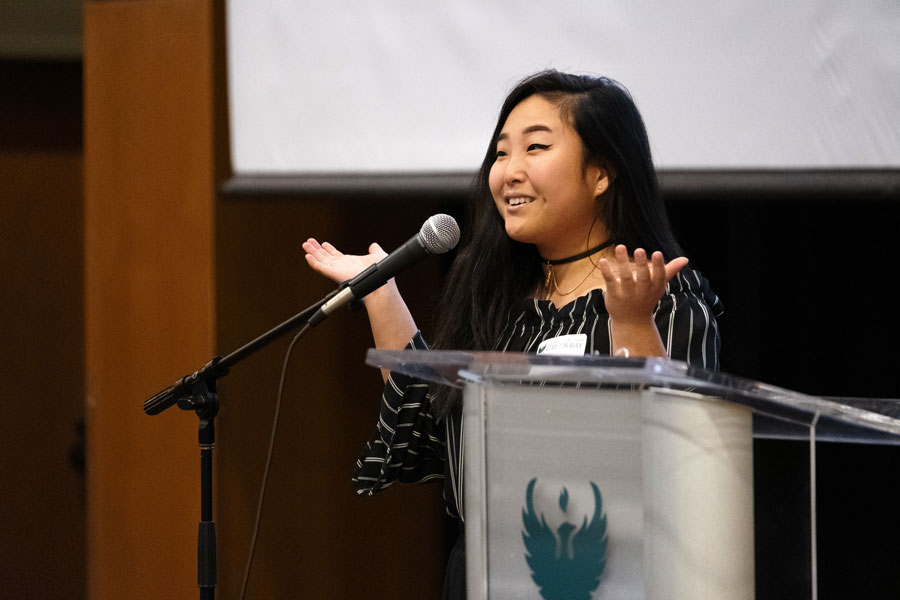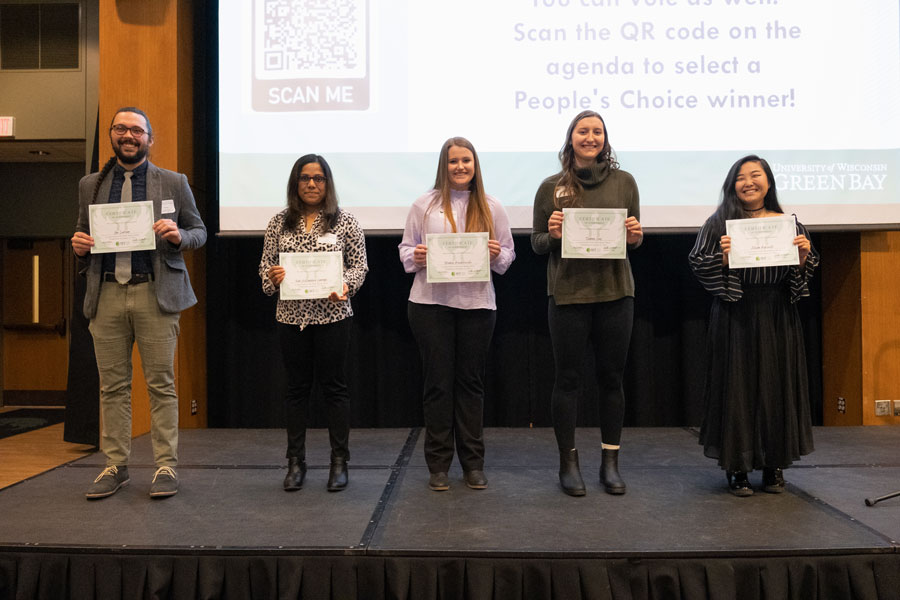Three Minute Thesis
Communicate Your Ideas
Explain your research in three minutes to a general audience.
UW-Green Bay Graduate Student Council and the Office of Graduate Studies are co-hosting the second annual Three Minute Thesis (3MT®) event! Developed by the University of Queensland, 3MT has been adopted in 86 countries and cultivates students’ academic, presentation and research communication skills. This unique academic competition is open to all currently enrolled graduate degree students at UW-Green Bay.
Save the date: January 28th, 2025


Why Participate?
There are plenty of reasons to present your research in an accessible way.
Participating in Three Minute Thesis means you can:
- prepare for job interviews
- practice at public speaking
- network with like-minded peers
- get more career opportunities
- And most importantly, earn awards and recognition!
2023

Three Minute Thesis Recordings
Watch recordings of UW-Green Bay graduate students presenting their research findings in three minutes or less with only one slide.
Spider (Araneae) Diversity at Red Banks Alvar State Natural Area
Jillian Kurvoski, MS in Environmental Science & Policy
The Effects of COVID-19 on College Students Pre- and Post-Vaccine
Brinley Kowalkowski, MS in Management Program
Relational Discipline: How We Can Make a Difference
Sydney Levy, MS in Applied Leadership for Teaching & Learning
Fashionista: The personalized fashion recommendation assistant
Isuri Gamage, MS in Data Science Program
Michigan Arctic Grayling Restoration Using Habitat Suitability Modeling
Zac Locklear, MS in Environmental Science & Policy Program
Participant Resources
If you are participating in the competition, the resources below will provide helpful information to guide you in preparing your presentation and we highly recommend reviewing them and the video link below before you attend a workshop.
Rules
- A single static PowerPoint slide is permitted. No slide transitions, animations or ‘movement’ of any description are allowed. The slide is to be presented from the beginning of the oration.
- No additional electronic media (e.g. sound and video files) are permitted.
- No additional props (e.g. costumes, musical instruments, laboratory equipment) are permitted.
- Presentations are limited to 3 minutes maximum and competitors exceeding 3 minutes are disqualified.
- Presentations are to be spoken word (e.g. no poems, raps or songs).
- Presentations are to commence from the stage.
- Presentations are considered to have commenced when a presenter starts their presentation through either movement or speech.
- The decision of the adjudicating panel is final.
Judging Criteria
Comprehension and content
- Did the presentation provide an understanding of the background to the research question being addressed and its significance?
- Did the presentation clearly describe the key results of the research including conclusions and outcomes?
- Did the presentation follow a clear and logical sequence?
- Was the topic, key results and research significance and outcomes communicated in language appropriate to a non-specialist audience?
- Did the speaker avoid scientific jargon, explain terminology and provide adequate background information to illustrate points?
- Did the presenter spend adequate time on each element of their presentation – or did they elaborate for too long on one aspect or was the presentation rushed?
Engagement and communication
- Did the oration make the audience want to know more?
- Was the presenter careful not to trivialize or generalize their research?
- Did the presenter convey enthusiasm for their research?
- Did the presenter capture and maintain their audience’s attention?
- Did the speaker have sufficient stage presence, eye contact and vocal range; maintain a steady pace, and have a confident stance?
- Did the PowerPoint slide enhance the presentation – was it clear, legible, and concise?
Drafting Your Presentation
Write For Your Audience
- Avoid jargon and academic language.
- Explain concepts and people important to your research – you may know all about Professor Smith’s theories but your audience may not.
- Highlight the outcomes of your research, and the desired outcome.
- Imagine that you are explaining your research to a close friend or fellow student from another field.
- Convey your excitement and enthusiasm for your subject.
Tell a Story
- You may want to present your 3MT as a narrative, with a beginning, middle and end.
- It’s not easy to condense your research into three minutes, so it's easier to break your presentation down into smaller sections.
- Try writing an opener to catch the attention of the audience, then highlight your different points, and finally have a summary to restate the importance of your work.
Have a Clear Outcome in Mind
- Know what you want your audience to take away from your presentation.
- Try to leave the audience with an understanding of what you’re doing, why it is important, and what you hope to achieve.
Revise
- Proof your 3MT presentation by reading it aloud, to yourself and to an audience of friends and family.
- Ask for feedback.
- Ask your audience if your presentation clearly highlights what your research is about and why it is important.
Preparing for your presentation
Slide Rules and Tips
Before you start work on your slide, you should take the following rules into account:
- One single static PowerPoint slide is permitted;
- No slide transitions, animations or ‘movement’ of any description are permitted;
- Your slide is to be presented from the beginning of your oration; and
- No additional electronic media (e.g. sound and video files) are permitted.
Slide Suggestions
- Less is more: text and complicated graphics can distract your audience—you don’t want them to read your slide instead of listening to your 3MT.
- Personal touches: personal touches can allow your audience to understand the impact of your research.
- Creativity drives interest: do not rely on your slide to convey your message—it should simply complement your oration.
- Work your message: think about how your slide might be able to assist with the format and delivery of your presentation—is there a metaphor that helps explain your research?
- An engaging visual presentation can make or break any oration, so make sure your slide is legible, clear and concise.
Presentation Tips
Practice, practice, practice
- Feeling nervous before you present is natural, and a little nervousness can even be beneficial to your overall speech. Nonetheless, it is important to practice so you can present with confidence and clarity. Practicing will also help you gauge the timing of your 3MT so that you keep within the time limit.
Record Yourself
- Record and listen to your presentation to hear where you pause, speak too quickly or get it just right.
- Then work on your weaknesses and exploit your strengths.
Dress
- There is no dress code, if you are unsure of how to dress you may like to dress for a job interview or an important meeting. It is important that you feel comfortable so you can focus on your presentation.
- If you are presenting on a stage that has a wooden floor, be aware of the noise your footwear might make.
- Do not wear a costume of any kind as this is against the rules (as is the use of props).

Connect With Us
If you have questions about our Three Minute Thesis competition, get in touch with anyone on our team at the Graduate Studies office.